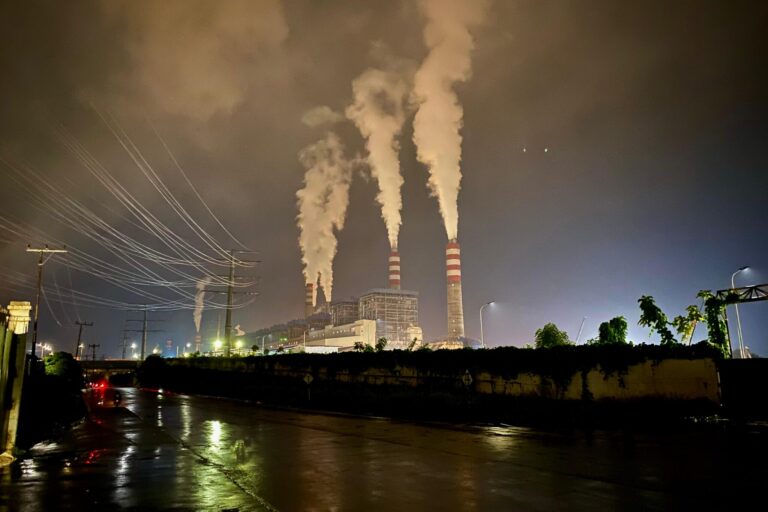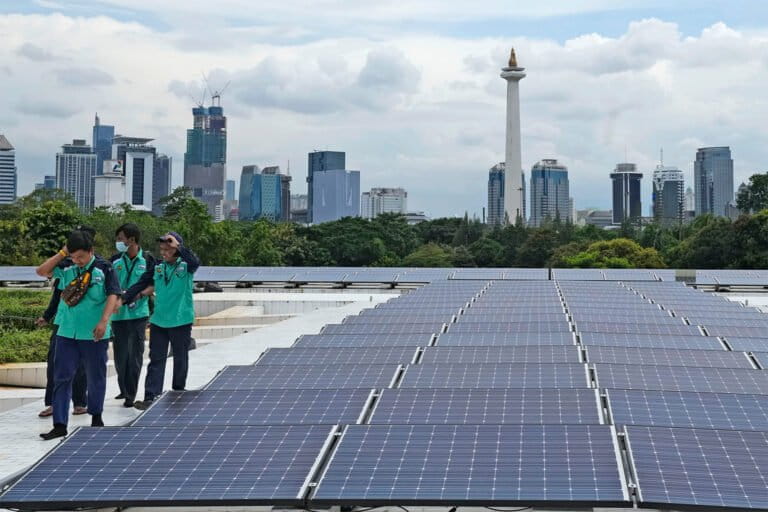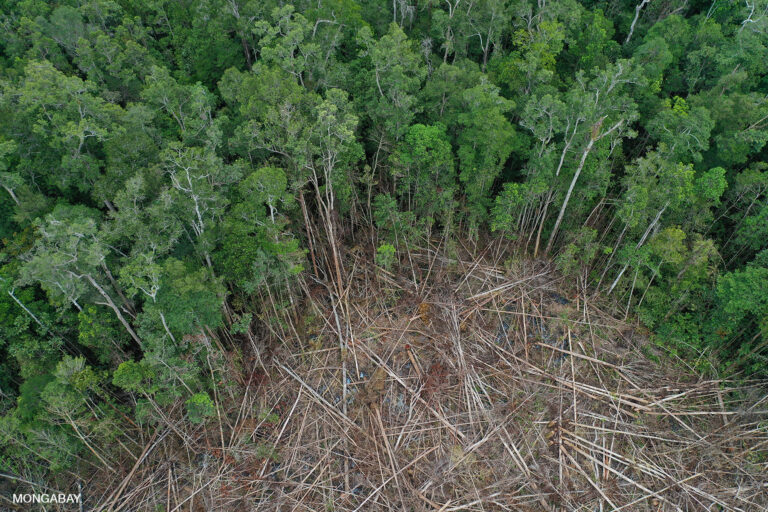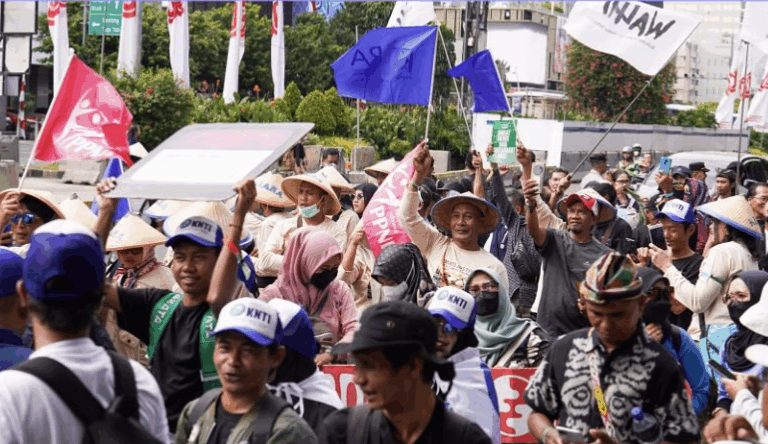- Indonesia’s newly submitted second nationally determined contribution (SNDC), in accordance with the Paris Agreement, contains emission-reduction targets widely seen as insufficient to meet the goal of limiting warming to 1.5° Celsius.
- This contrasts with President Prabowo Subianto’s pledges to achieve 100% renewable energy by 2035 and to phase out coal within 15 years, raising hopes that Indonesia could embark on a genuine energy transition.
- Under the SNDC’s high-growth scenario of 8% annual economic growth, Indonesia’s emissions are projected to be roughly 30% higher in 2035 than in 2019; in contrast, a 1.5°C-compatible pathway would require a 21% reduction.
- Critics say this suggests deep climate action is still seen as incompatible with rapid economic growth.
JAKARTA — Indonesian President Prabowo Subianto has made bold pledges to achieve 100% renewable energy by 2035 and to phase out coal within 15 years, raising hopes that one of the world’s largest greenhouse gas emitters might finally embark on a genuine energy transition — pivotal if the world is to have any chance of limiting warming to 1.5° Celsius (2.7° Fahrenheit).
Yet Indonesia’s newly submitted climate plan tells a different story.
Under the Paris Agreement, countries must submit nationally determined contributions (NDCs), updated every five years, outlining their emission-reduction goals and adaptation measures.
Indonesia’s latest submission, the second nationally determined contribution (SNDC), suggests that deep climate action is still seen as incompatible with rapid economic growth, according to critics.
As a result, the SNDC contains emission-reduction targets that are widely seen as insufficient to meet the 1.5°C goal. The document updates Indonesia’s targets for 2031-35 and replaces the earlier “enhanced NDC” of 2022.
Unlike the 2022 document that used a business-as-usual baseline, the new SNDC uses 2019 as its reference year.
Officials say this shift improves transparency; environmental analysts say it masks ambition, since absolute emissions continue to rise until at least 2030 and only decline modestly by 2035, reflecting a government model that, according to analysts, still assumes deep emissions cuts will slow economic growth.
Under the SNDC’s high-growth scenario (8% annual economic growth), Indonesia’s emissions are projected to be roughly 30% higher in 2035 than 2019 levels. In contrast, a 1.5°C-compatible pathway would require a 21% reduction by 2035 from 2019, according to analysis from the Climate Action Tracker.
This represents a large gap between policy and science in the sixth-largest greenhouse gas emitter globally, critics say.

No true energy transition
What underpins the projected emissions growth is the weak pace of fossil fuel transition and modest renewable targets.
The SNDC sets a goal of just 19-23% renewable energy share by 2030, directly at odds with Prabowo’s public pledge.
During a July 2025 visit to Brazil, Prabowo said the target of 100% renewables originally set for 2040 could be achieved by 2035.
He also linked his target to tripling renewables and pledged to retire all coal-fired power plants by 2040.
The SNDC does not explicitly commit to a coal phaseout timetable nor to retiring existing coal plants. Instead, it focuses on technical fixes, such as clean-coal technologies and efficiency gains, while the latest national energy plan foresees 16.6 GW of new fossil-based generation until 2034 (10.3 GW gas, 6.3 GW coal).
Independent technical analysts argue that for a 1.5°C-aligned pathway, Indonesia’s energy-sector emissions must peak no later than 2030, ideally in the mid-2020s — a far earlier point than the current SNDC implies.
Sisilia Nurmala Dewi of climate NGO 350.org, called the SNDC “a bitter disappointment.”
“This glaring disconnect between presidential rhetoric and official policy raises serious questions about the government’s sincerity and commitment to climate action,” the Indonesian team lead for the NGO said in a press release.

Economic growth
The SNDC models three growth scenarios and explicitly links emissions trajectories to different growth assumptions: One scenario assumes 6% growth, another 8%. Under both scenarios, emissions rise through 2030 and only modestly decline in 2035.
Critics argue this signals a modeling logic that treats climate ambition and economic growth as trade-offs.
Ary Sudijanto, the deputy minister for climate change and carbon governance at the Ministry of Environment, confirmed this during a recent public consultancy of the second NDC in Jakarta.
“If asked whether Indonesia’s SNDC is already Paris Agreement-compatible — meaning a 43% reduction [of global greenhouse gas emissions] by 2030 and 60% by 2035 — honestly, not yet. Our projections are still above the required trajectory [to limit global warming to 1.5°C],” he said. “But we want our commitments to remain realistic and achievable, avoiding overpromising that could harm economic stability.”
This view, however, is increasingly outdated and contradicted by modeling from Indonesia’s national planning agency, Bappenas, said Fabby Tumiwa, the executive director of Jakarta-based think tank Institute for Essential Services Reform.
Bappenas’ Low-Carbon Development Indonesia (LCDI) modeling shows that stronger climate action is not a cost to growth — it’s a prerequisite for it.
The LCDI modeling, commissioned by Bappenas and supported by the World Bank, found that low-carbon growth could add 1% to Indonesia’s GDP by 2045 compared with a business-as-usual path.
IESR points out that investing in the energy transition — estimated at up to $40-50 billion per year — could generate jobs in green sectors, reduce electricity costs and unlock Indonesia’s renewable potential (about 3,800 GW).
“Solar PV and battery energy storage now produce power that is more competitive than diesel, gas or coal plants. The falling costs of renewables support the president’s energy transition vision. Keeping old coal plants running only deprives Indonesia of cheaper electricity,” Fabby said.

FOLU net sink
But instead of introducing a meaningful energy transition strategy, one that involves emission reduction strategies like early coal retirement, the second NDC relies heavily on the forestry and other land use (FOLU) sector as the main mitigation strategy.
At the COP26 climate conference in 2021, the government introduced an ambitious plan to turn Indonesia’s forests into a carbon sink by 2030, a state where carbon absorption in the FOLU sector is greater than its emissions.
The plan, known as FOLU Net Sink 2030, include reducing deforestation, increasing carbon reserves and promoting sustainable forest management.
The role of the FOLU sector in Indonesia’s climate policy has become greater in the SNDC, with the sector expected to absorb roughly 118 million tons of CO₂e in 2030 and 206 million tons in 2035.
“The FOLU sector is our ‘sector of hope,’ contributing the largest emission reductions,” Ary said.
Yet this reliance raises serious risks: land use change, peat fires and deforestation reversals can turn sinks into sources.
As the Intergovernmental Panel on Climate Change (IPCC)’s 2022 Mitigation Report notes, while the AFOLU sector offers short-term mitigation potential, it cannot substitute for delayed emissions cuts elsewhere.
“The government must act now to end fossil fuels in the energy sector — not hide behind our forests,” Sisilia of 350.org said.

Deforestation risk
While some experts recall the risk of being overly reliant on the FOLU sector, others say the government can afford to be more ambitious in its FOLU target.
Indonesia is home to the third-largest expanse of tropical rainforest in the world, which has rapidly shrunk in the past due to unbridled exploitation and industrial expansion.
But deforestation rates have dramatically declined in recent years to below 100,000 hectares (247,000 acres) per year, so much so that Indonesia’s forest cover actually increased by 94,100 hectares (232,500 acres) over the past decade.
According to FAO’s latest Forest Resources Assessment, Indonesia reported 96 million hectares (237 million acres) of forest area in 2025, an increase from 95 million hectares (235 million acres) in 2015. Indonesia also reported a net gain of 12,500 hectares (31,000 acres) of naturally regenerating forests per year in 2015-25, a turnaround from the 1990-2000 period, when the country lost roughly 2.5 million hectares (6.2 million acres) of forest per year.
Therefore, the allocation of 300,000 hectares (741,000 acres) of annual deforestation in the SNDC is alarmingly high, according to watchdog Forest Watch Indonesia executive director Mufti Barri.
“The actual rate of deforestation in Indonesia in recent years has already fallen below 100,000 hectares per year — so why does the SNDC raise the threshold to 300,000 hectares?” he said. “[So] how ambitious is this target, really? Could we not be more ambitious?”
Therefore, the SNDC risks legalizing higher forest loss, especially in the remaining forest frontiers in eastern Indonesia, like Papua, Sulawesi and Maluku.
Ary argued that the 300,000-hectare figure refers to areas zoned as “forest”— not necessarily tree-covered.
But Raynaldo Sembiring, the executive director of the Indonesian Center for Environmental Law, said Indonesia still has 9.8 million hectares of natural forests within concessions that must be protected, regardless of zoning.

Lack of public participation
Observers attribute the many weaknesses in the second NDC partly to the lack of meaningful public participation in the drafting of the document.
Some civil society organisations say they received the draft only one day before the consultation on Oct. 23, 2025 — or not at all — and that the document was submitted to the U.N. only one day after the consultation, leaving little room for meaningful input.
“Civil society had no clear pathways to influence the decisions made — a clear injustice to vulnerable communities who will continue to suffer most from such inadequate climate action masquerading as ambition,” Sisilia said.
Many groups described the consultation as a mere socialization exercise, since the draft was already finalized and substantive input could no longer be incorporated.
“Substantive feedback cannot be integrated into this SNDC submission but will inform future updates,” Ary said during the public consultation after receiving extensive feedback from civil society groups.

No robust climate adaptation
That lack of inclusion, observers say, also undermines Indonesia’s adaptation planning, according to the Working Group on Indigenous Peoples’ and Community Conserved Areas and Territories Indonesia (WGII) knowledge management officer Lasti Fardilla Noor.
While the second NDC mentions traditional wisdom as best practice, it fails to recognize the living spaces of Indigenous peoples and local communities as an integral part of the national adaptation strategy, she said.
In reality, living spaces such as forests, rivers, coasts and local farmlands — managed through traditional knowledge and customary systems — are the lifeblood of communities and represent the most effective long-standing adaptation systems.
While there have been many local recognitions of community territories, they’re not yet incorporated into Indonesia’s formal spatial planning.
Community rights activists say this omission reflects a deeper failure to integrate social justice into Indonesia’s climate policy.
As a result, many development projects, including those for climate mitigation, such as renewable energy, often overlap with community territories, resulting in their displacement and the violation of their rights, according to Agung Wibowo, the executive director of HuMa, a community rights NGO.
Without recognizing the rights of vulnerable groups and resolving the conflicts affecting them, the SNDC will exacerbate latent tenure conflicts and create jurisdictional fragmentation among state institutions, he added.
“Such outcomes will worsen agrarian and natural resource conflicts in Indonesia — generating social and environmental costs, legal disputes and even local violence that remain unaccounted for in the NDC formulation,” Agung said.
For now, Indonesia’s new climate plan risks undercutting Prabowo’s sweeping promises.
Without a faster fossil-fuel phaseout, stronger adaptation measures and genuine public participation, experts warn that Indonesia could lock itself into another decade of high emissions and missed opportunities for a just, low-carbon transformation.
“Instead of treating the climate crisis as a matter of justice,” said Boy Jerry Even Sembiring, executive director of the Indonesian Forum for the Environment, WALHI, “the SNDC continues to frame it as a development challenge to be managed technocratically — ignoring that the climate crisis is rooted in structural injustice.”
Banner image: View of Suralaya coal power plant in Banten Province, Indonesia. Image © Ulet Ifansasti / Greenpeace.
FEEDBACK: Use this form to send a message to the author of this post. If you want to post a public comment, you can do that at the bottom of the page.
